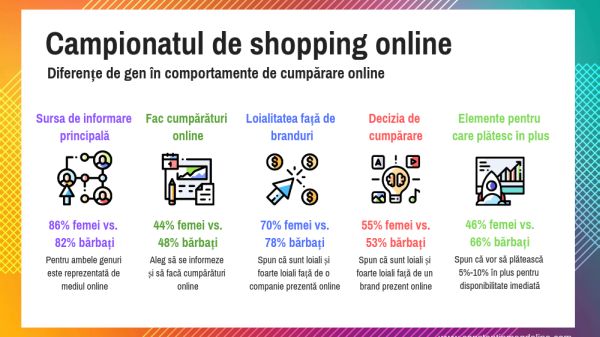In order to find answers to these questions and to many others, Valoria conducted the study "Purchasing Behavior in the Digital Consumer Age". The study collected 1960 responses with a national distribution relevant to an urban sample.
Only to find the specific behaviors of each genre we have shared the information relevant for the comparative analysis of the two genres according to each stage of the purchase process. Here are the results.
Search and selection of information
Since women are more relational than males, their main source of information is friends and acquaintances (60% vs. 43%), only the online environment (86% for women and 82% for males) is the source for both genres. The most influential advertisements are those in websites (63% in their case compared with 50% in the case of women), but women are more influenced by advertisements in social networks (56%, compared with 35% for men)
The most influential are the commercials in stores, both for women (62%) and for men (61%). Only 42% of women and 51% of men consider online useful information. The analysis shows that 44% of women and 48% of men are informing and buying online, the next identified behavior being those who are online but shoppers (34% in both cases).
Loyalty to the brand
Men are more transactional than women in buying behaviors: 54% say a better offer would cause them to change their choice of the services or products of a brand they are currently buying compared to only 37% of women who say they would do the same.
Both women (70%) and men (78%) say they are loyal and very loyal to an online company and only 17% of men and 14% of women are loyal and very loyal to an online company.
The purchasing decision
When purchases are made online, the purchasing decision is influenced by the information presented by 74% of men and 75% of women. Delivery time is 76% for men and 69% for women, and for merchandise / services sold, 65% for men and 71% for women.
Based on the results obtained, the hypothesis that the local market is price sensitive is verified, as the price and terms of delivery are the main factors taken into account for the purchasing decision of both women (55%) and men (53%), followed by the brand and image (12% for men and 18% for women).
The rating offered by other users in the online environment influences the choice of the desired product / service much and much for 72% of men 76% of women.
The buying process
Of all the products purchased in the online environment, electronics and home appliances are the first for both women (74%) and men (91%).
In the second place are clothing and footwear, 74% for women and 66% for men.
In terms of products bought in the store, food is the first for both 96% of women and 93% of men, followed by clothing / footwear, 82% for women and 85% for men.
The most used payment methods are: cash payment (50% for men and 36% for women), card payment (33% for men and 39% for women) and bank transfer (9% for men and 17%. 67% of men and 63% of women would be willing to pay between 5% -10% more for digital services to save time and give them a very good buying experience.
The characteristics for which they would be willing to pay more are: immediate availability (66% for men and 46% for women) and low delivery times (66% for men and 56% for women).
Post-purchase experience
In terms of post-purchase experience, the most important for men is warranty assistance (35%), followed by technical assistance (28%), but for women, the most important is the assistance provided to the clients (35%), followed by the assistance in warranty (28%).
Consumer feedback sent through social media platforms is considered by 55% of women and 45% of men as a good mechanism to discover and validate information in an objective manner and a new way of expressing dissatisfaction for 26% of men and 25% of women.
In conclusion
Beside the traditional physical environment, the results of an "online shopping championship" might surprise. There are categories of privileged men's products and different values of products or services purchased by them compared to those purchased by women. The online buying behaviors differ and highlight men's transactional approaches and the more relational approaches of women. In fact, the race is not between who buys more, men or women, but between the online stores.The way they will work with vendors, improve the online platforms, offer competitive pricing, or how they will be able to use analytical data to build predictive growth models will depend on their success in the future.






























